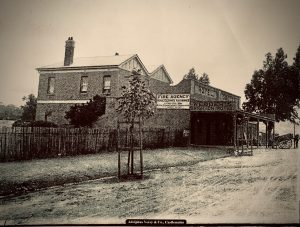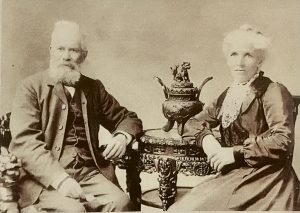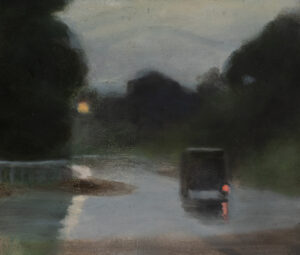About
The Northern Arts Hotel features nine boutique guest rooms, function areas, a sitting room and a private upstairs balcony.
Following a three-year-long refurbishment by former furniture maker Nicholas Dattner, the hotel opened as a guesthouse in 2013. Featuring rich timber panelling and an art deco ceiling with an extensive collection of antiques, paintings and quirky objects, the Northern Arts Hotel shares much in common with some of the great art hotels worldwide.
The History of the Building

Gold was discovered in nearby Barkers Creek in July 1851, and a two-storey bakery existed on the site by the late 1850s. One recent visitor, Denise Dodd, filled in some early details.
He successfully supported himself and gathered enough capital to pursue an alternative career by supplying the hopeful miners with their daily bread and other worldly goods. He bought a town lot in Castlemaine in August of that year for 89 pounds at auction. This sum provided him with a corner block on Barker Street; being on the main road and entrance to the town from the diggings on the north side, it seemed like an ideal place to open a bakery, and by 1858, John had erected a two storey brick building with residence, now known as the Northern Arts Hotel which occupies the site today and has since developed a series of extensions and modifications to Johns original building.
The current version of the building existed by 1873 and was renamed as the Brighton Hotel and Store with Harry Excell as Licensee. The rear section was built in 1908, and the name changed from Webber’s Brighton Hotel and Store to just Webbers Hotel in 1913, whilst the front was rebuilt in Art Deco style in 1939 when it became the Northern Hotel.
During the later part of the 19th and 20th centuries, the hotel’s success largely depended on the adjacent Thompsons Foundry (est. 1875). The function room and drive-thru (now a gourmet bakery) were completed in 1990. New owner Nick Dattner changed the name after renovation to the New Northern in 2013. Located at the quiet northern end of town, the Northern Arts Hotel emerged under current owner Maggie Fooke and continues to be a celebrated part of creative Castlemaine.
Faces of 359 Barkers St: Harry & Ann Excell

The Northern Arts Hotel opened on the site at 359 Barker Street in 1873 as the Brighton Hotel and Store, with Harry Excell as the licensee. Harry and his extended family were born and lived in Brighton, England, before they emigrated to Australia. Harry arrived in Castlemaine in 1857, aged 19, with his widowed mother, Ann.
Harry and his family moved to Central Otago, New Zealand, while his mother remained in Castlemaine, died, and was buried there in 1888. The name Brighton Hotel would stay until 1913.
He appears to make some money from gold, which might well be how he became a publican! An annual licence could be obtained upon payment of 8 pounds per year or two pounds for three months.
A quirky moment in history is reported in the gossip column from 1913.

‘When I drink not wisely, but too well, it will be at the aristocratic Brighton Hotel,’ The Sergeant must really be more careful if he is anxious to be thought well of by the Temperance party. On Thursday evening, a man who was very drunk found his way back to the Brighton Hotel, North Castlemaine, and demanded more beer. On this being refused, he became so importunate that Mr Webber telephoned for the police, who arrived shortly after with a motor car, in which they conveyed the offender to the lockup. When asked at the Police Court how he pleaded to a charge of being drunk on licensed premises, he replied: — “I believe that is a fact, Guilty.”
He was fined 10 shillings, in default, three days’ imprisonment. Costs nil. When I break out and drink not wisely, but too well, it will be at the aristocratic Brighton Hotel, where the police wait on ”drunks” with a motor car in which they are conveyed luxuriously to their destination— without costs. Mr Webber should supply the police with free drinks; they deserve it. The business will be brisker than ever at North Castlemaine.
Our Room Names
The Rooms in our hotel are named after well-regarded Australian artists. Interested in who we named the Rooms after? Visit here to see some information about each room and artist. The image at right is ‘Wet evening’ by Clarice Beckett and is on view often at our local Castlemaine Art Museum. Find more information here
The rooms and artists are Room 1 – Clifton Pugh, Room 2 – Clara Beckett, Room 3 – Margaret Olley, Room 3A – Mirka Mora, Room 4 – Arthur Boyd, Room 5 – Brett Whiteley, Room 6 – John Olsen, Room 7 – Hans & Nora Heysen, Room 8 – Margaret Preston.
Thompsons Foundry [from 1875 to present day]

It is hard to approach the Hotel and not notice the saw-tooth roof of the dominant building behind us. The saw-tooth roof of the original Thompsons Foundry [est 1875] appeared around 1910’s as the then Thompsons Foundry expanded leading up to WW1.
Thompsons’ Foundry has played a pivotal role in the economic sustainability and well-being of Castlemaine since it first opened its doors in 1875. It would be surprising to find a family in town that hasn’t had a member working there at some point. Once the foundry was established, the hotel on our site, whether the Brighton, Webbers or the Northern, rode on the back of its workers. The hotel’s fortune on our site has strong links to the foundry as it was the closest pub and, in its heyday, was the pub that workers who mostly came to work by bicycle would stop at knock-off time. The long bike shed you can see over our back fence held over 200 bikes at a time.
 Thompsons continues in some form through Flowserve, the American company that now owns the business. Much of the original success of Thompson’s is attributed to the technical knowledge of their designing, engineers, the works Superintendent, planning engineer and foremen, and to the knowledge and skill of the employees who have identified themselves with the Works, in some cases for three generations. The manufacturers of Thompson’s were well known as work of the highest quality and of excellent design.
Thompsons continues in some form through Flowserve, the American company that now owns the business. Much of the original success of Thompson’s is attributed to the technical knowledge of their designing, engineers, the works Superintendent, planning engineer and foremen, and to the knowledge and skill of the employees who have identified themselves with the Works, in some cases for three generations. The manufacturers of Thompson’s were well known as work of the highest quality and of excellent design.
But the Foundry wasn’t just a major employer in Castlemaine, with no less than three separate sporting teams and one of this country’s oldest brass bands. The Foundry has contributed to this town’s social, cultural and sporting fabric like few others.
Below are more images from the Foundry’s history and some recent ones.






